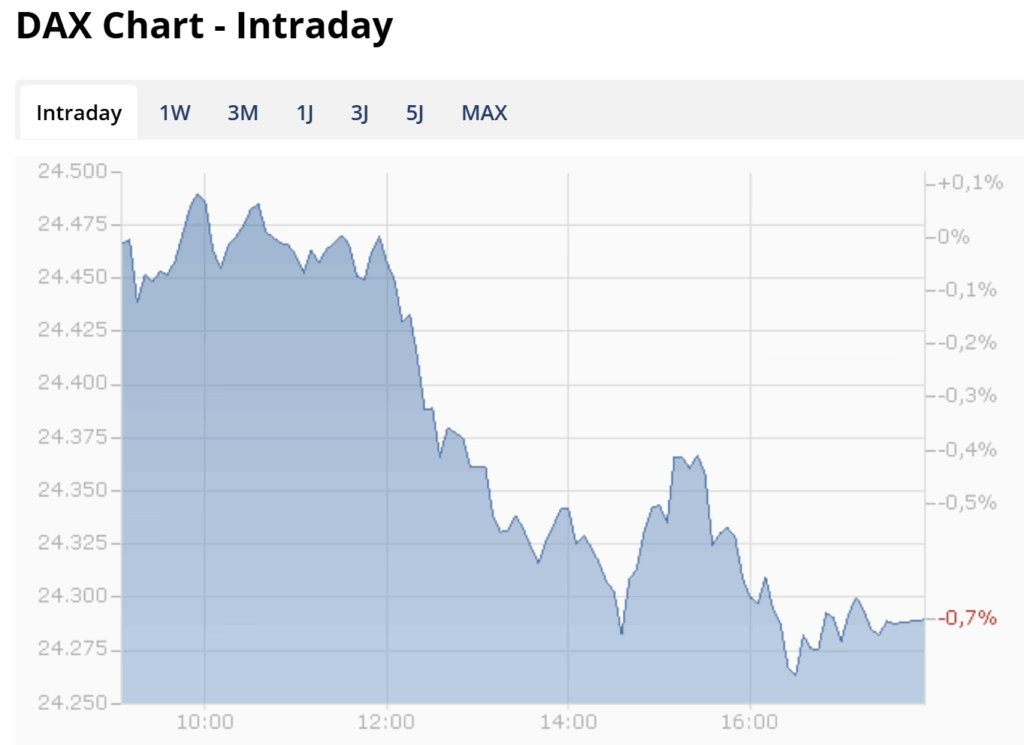Daily Recap: DAX Slips from Intraday Highs as Summer Volatility Returns
Germany’s DAX 40 index finished Friday, July 18, 2025, slightly in the red, closing down 0.3% at 24,289 points. The day began on a strong note with an open near 24,484, but optimism faded through the session as investors locked in gains amid light summer trading volumes and mixed corporate earnings.
This late-week drift lower didn’t erase earlier progress—the DAX still logged a modest +0.1% weekly gain, its second straight positive week. The pattern mirrored broader European equity markets: the Euro Stoxx 50 lost 0.33%, while the STOXX 600 closed flat. Notably, the UK’s FTSE 100 outperformed with a +0.2% gain, lifted by rising energy shares.
Investor sentiment in Europe remained cautious but resilient, with sharp selloffs in underperformers offset by gains in well-received earnings releases, especially in industrials and energy.

Technical Snapshot: Bullish Bias, But Facing Resistance
From a technical standpoint, the DAX remains within a well-defined uptrend, but near-term momentum is stalling as it approaches key resistance.
- Moving Averages: The 50-day moving average (~23,300) continues to act as dynamic support. The index has not closed below it in weeks, reinforcing the uptrend.
- RSI: The Relative Strength Index hovers around 55–60, showing steady but not overheated momentum. The recent bounce off neutral territory confirms bullish undercurrents.
Key Levels to Watch:
- Resistance: 24,500 (intraday resistance), 25,000 (psychological barrier), 25,100 (channel top).
- Support: 24,200 (short-term floor), 24,000–23,800 zone (20-day moving average), and 23,500 (March high).
Summary: A break above 24,500 could accelerate upside momentum, but without new catalysts, consolidation in the 24,000–24,500 range remains likely.
Macro Drivers: ECB Pivot, Trade Friction, Earnings Volatility
1. ECB Policy Shift: Lower Rates, Lower Growth
For the first time in two years, eurozone inflation dropped to 2.0%, hitting the European Central Bank’s official target. This has cemented the ECB’s dovish pivot—200 basis points in rate cuts over the past year—with markets expecting another reduction by December to bring rates to around 1.75%.
Lower interest rates are typically supportive for equities, but they also reflect the fragility of eurozone growth, currently hovering below 1%. The upcoming ECB meeting on July 24 will be closely watched for further signals.
Investors are hoping for reassurance—but wary of how much easing power the ECB has left.
2. U.S.-EU Trade Tensions: A Growing Risk
Markets briefly sold off after reports that President Trump is pushing for 15–20% tariffs on EU imports. Germany’s export-heavy economy, especially its automotive sector, is vulnerable.
- Shares of Volkswagen, BMW, and Mercedes-Benz fell 1–2% this week.
- Analysts warn that retaliatory measures could hit European industrials and sentiment hard.
While some dismiss the threats as posturing—the so-called “TACO” trade (Trump Always Chickens Out)—the August 1 deadline has introduced a new layer of uncertainty.
3. Earnings Season: Mixed Bag, Sharp Reactions
Q2 earnings remained in focus, with European companies seeing highly selective investor responses:
- Beats: ABB, Legrand, and several industrial firms exceeded expectations, offering stability.
- Misses: GSK dropped 4.6% after a cancer drug was rejected by a U.S. FDA panel, dragging down healthcare shares.
- Energy Stocks: Oil strength helped lift the STOXX Europe Oil & Gas index by ~0.6%.
Bond markets were relatively quiet, with 10-year German bund yields around 2.68%, reflecting expectations of continued monetary support from the ECB.
Short-Term Outlook: Rangebound with Upside Bias
Looking ahead, analysts expect the DAX to remain rangebound in the near term as traders await clarity on:
- The July 24 ECB meeting
- Tariff developments between the U.S. and EU
- Earnings from key German multinationals
A clean breakout above 24,500 could open the door toward the psychological 25,000 mark, especially if external risks subside. But with the index already up more than 15% year-to-date, many traders may be reluctant to chase prices without confirmation from either macro or earnings catalysts.
For now, dips toward 24,000 are likely to attract buyers, while rallies near 24,500 may invite selling—until momentum clearly shifts.
Conclusion: Strong Base, Cautious Climb
The DAX remains in an encouraging technical setup, but recent price action suggests fatigue near highs. A short period of sideways movement could reset sentiment and allow for a more sustainable advance. Unless geopolitical or earnings risks escalate, dips are still being seen as buying opportunities, not warning signs.

